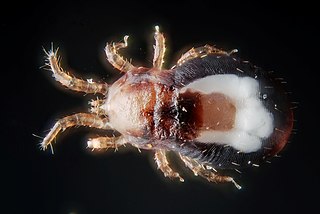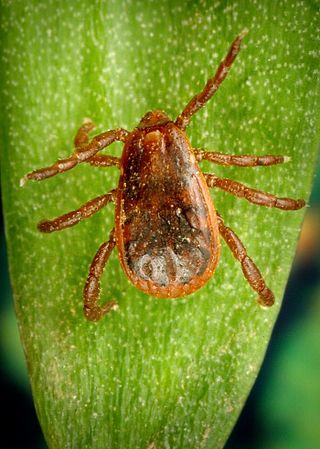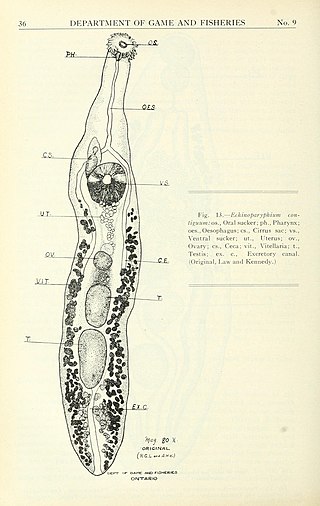
Chagas disease, also known as American trypanosomiasis, is a tropical parasitic disease caused by Trypanosoma cruzi. It is spread mostly by insects in the subfamily Triatominae, known as "kissing bugs". The symptoms change over the course of the infection. In the early stage, symptoms are typically either not present or mild, and may include fever, swollen lymph nodes, headaches, or swelling at the site of the bite. After four to eight weeks, untreated individuals enter the chronic phase of disease, which in most cases does not result in further symptoms. Up to 45% of people with chronic infections develop heart disease 10–30 years after the initial illness, which can lead to heart failure. Digestive complications, including an enlarged esophagus or an enlarged colon, may also occur in up to 21% of people, and up to 10% of people may experience nerve damage.

Dirofilaria immitis, also known as heartworm or dog heartworm, is a parasitic roundworm that is a type of filarial worm, a small thread-like worm, and which causes dirofilariasis. It is spread from host to host through the bites of mosquitoes. Four genera of mosquitoes transmit dirofilariasis, Aedes, Culex, Anopheles, and Mansonia. The definitive host is the dog, but it can also infect cats, wolves, coyotes, jackals, foxes, ferrets, bears, seals, sea lions and, under rare circumstances, humans.
Acanthocheilonema is a genus within the family Onchocercidae which comprises mainly tropical parasitic worms. Cobbold created the genus Acanthocheilonema with only one species, Acanthocheilonema dracunculoides, which was collected from aardwolf in the region of South Africa in the nineteenth century. These parasites have a wide range of mammalian species as hosts, including members of Carnivora, Macroscelidea, Rodentia, Pholidota, Edentata, and Marsupialia. Many species among several genera of filarioids exhibit a high degree of endemicity in studies done on mammalian species in Japan. However, no concrete evidence has confirmed any endemic species in the genus Acanthocheilonema.

The Lloyds Bank coprolite is a large coprolite, or fossilised specimen of human faeces, recovered by the York Archaeological Trust while excavating the Viking settlement of Jórvík in northern England.

Panstrogylus geniculatus is a blood-sucking sylvatic insect noted as a putative vector of minor importance in the transmission of Trypanosoma cruzi to humans; this is a parasite, which causes Chagas disease. The insect is described as sylvatic; subsisting primarily in humid forests, and is also known to inhabit vertebrate nesting places such as those of the armadillo, and is also involved in enzootic transmission of T. cruzi to those species. It has wide distribution throughout 16 Latin American countries.

The cat flea is an extremely common parasitic insect whose principal host is the domestic cat, although a high proportion of the fleas found on dogs also belong to this species. This is despite the widespread existence of a separate and well-established "dog" flea, Ctenocephalides canis. Cat fleas originated in Africa but can now be found globally. As humans began domesticating cats, the prevalence of the cat flea increased and it spread throughout the world.

Dermanyssus gallinae is a haematophagous ectoparasite of poultry. It has been implicated as a vector of several major pathogenic diseases. Despite its common names, it has a wide range of hosts including several species of wild birds and mammals, including humans, where the condition it causes is called gamasoidosis. In both size and appearance, it resembles the northern fowl mite, Ornithonyssus sylviarum.

Rhipicephalus sanguineus, commonly called the brown dog tick, kennel tick, or pantropical dog tick, is a species of tick found worldwide, but more commonly in warmer climates. This species is unusual among ticks in that its entire lifecycle can be completed indoors. The brown dog tick is easily recognized by its reddish-brown color, elongated body shape, and hexagonal basis capituli. Adults are 2.28 to 3.18 mm in length and 1.11 to 1.68 mm in width. They do not have ornamentation on their backs.

Thelazia callipaeda is a parasitic nematode, and the most common cause of thelaziasis in humans, dogs and cats. It was first discovered in the eyes of a dog in China in 1910. By 2000, over 250 human cases had been reported in the medical literature.
A trypanocidal agent is an antiprotozoal agent that acts upon trypanosome parasites.

Vetufebrus is an extinct genus of haemospororida in the family Plasmodiidae. At the time of its description the new genus comprised a single species Vetufebrus ovatus known from a single Miocene Dominican amber fossil found on Hispaniola. V. ovatus was vectored by Enischnomyia stegosoma, the first fossil streblid bat fly described from a fossil, and the only member of the subfamily Nycterophiliinae described from Hispaniola. V. ovatus is the first instance of a Streblidae bat fly as a host for a malarial parasite.
Galba neotropica is a species of air-breathing freshwater snail, an aquatic pulmonate gastropod mollusk in the family Lymnaeidae, the pond snails.

Anopheles sinensis is a species of mosquito that transmits malaria as well as lymphatic filariasis. It is regarded as the most important vector of these human parasitic diseases in Southeast Asia. It is the primary vector of vivax malaria in many regions. In China it also transmits the filalarial parasite, and arthropod roundworm. In Japan it is also a vector of a roundworm Setaria digitata in sheep and goats.

Fluralaner, (INN) sold under the brand name Bravecto among others, is a systemic insecticide and acaricide that is administered orally or topically. The US Food and Drug Administration (FDA) approved it for flea treatment in dogs in May 2014, and approved the combination fluralaner/moxidectin as a topical treatment for cats in November 2019. The EU approved fluralaner in March 2014. Australia approved it for the treatment and prevention of ticks and fleas on dogs in January 2015. For treating mites in chickens, a solution for use in drinking water is available under the brand name Exzolt and was approved for use in the EU in 2017.

Echinoparyphium is a genus of trematodes. Intermediate hosts include snails, bivalves and fish. Definitive hosts are mainly birds and mammals.

Enischnomyia is an extinct genus of bat fly in the family Streblidae. At the time of its description the new genus comprised a single species, Enischnomyia stegosoma, known from a single Miocene fossil found on Hispaniola. E. stegosoma was the first fossil streblid bat fly described from a fossil, and the only member of the subfamily Nycterophiliinae described from Hispaniola. The species is host for the plasmodiid Vetufebrus ovatus preserved in its salivary glands and midgut.

Allantonematidae is a family of insect-parasitic nematodes from the order Tylenchida. Allantonematid nematodes infect a variety of insects including beetles, butterflies, flies, thrips, ants, and more. For instance, the nematode Howardula aoronymphium parasitizes mushroom-feeding fruit flies, Formicitylenchus oregonensis parasitizes carpenter ants, and Metaparasitylenchus hypothenemi parasitizes a pest of coffee beans, the coffee berry borer.
Phortica variegata is a species of vinegar fly in the family Drosophilidae. Phortica and related fly species are perhaps best known for their behaviour of feeding on the lacrimal secretions of mammals. As a consequence of this behaviour, P. variegata can serve as a vector of Thelazia callipaeda roundworms.
Odile Bain was a French parasitologist.
Baylisascaris schroederi is a species of roundworm in the family Ascarididae. It occurs in China and is a parasite of giant pandas. Many wild giant pandas are infected with this parasite.













